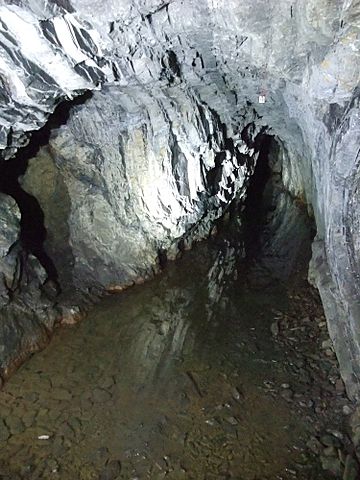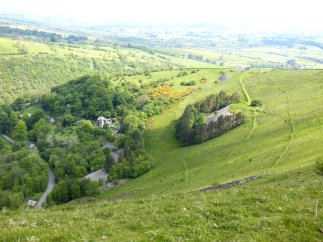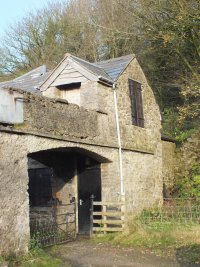Ecton Mines facts for kids
Ecton Hill in Staffordshire, England, is home to a group of old mines. What makes them special is that they mostly dug for copper, not lead or zinc, which was common in the Peak District. The most important mine, Deep Ecton, has been used since the Bronze Age. In the 1700s, it was a huge copper producer and the deepest mine in Britain! Mining stopped below river level in the 1850s, and all work ended by the 1890s. Today, Ecton Mine is an important place for learning. It's managed by the Ecton Mine Educational Trust, and the Ecton Hill Field Studies Association helps teach students there.
Where is Ecton Hill and What's its Geology?
Ecton Hill is a historic mining area near Ecton, Staffordshire. It used to be a very important place for copper mining in central England. Now, it's a protected site called a scheduled monument. You can find it in the Staffordshire Moorlands. Here, the River Manifold valley cuts through old limestones from the Lower Carboniferous period. These rocks were folded and faulted a long time ago. This area has a lot of copper, lead, and zinc minerals. It's unusual to find so much copper here compared to other places nearby.
A Look Back: The History of Ecton Mines
People started digging for copper at Ecton Hill about 3,500 years ago, during the Bronze Age. Mining continued until 1891. Over these years, some people became rich, while others lost everything. In the 1700s, the Duke of Devonshire made over £300,000 from the mines. It's said that this money helped build the amazing Crescent building in Buxton. Experts believe that over 100,000 tonnes of ore, mostly copper, were dug out of these mines.
Ecton Hill is a Site of Special Scientific Interest (SSSI), which means it's a special place for nature and science. The Ecton mine itself is an underground SSSI. Nearby, at Ape's Tor, you can see cool rock formations. You can then see similar structures underground in places like Salt's Level.
The busiest time for mining at Ecton was in the late 1700s. Deep Ecton was the richest mine and the deepest in Britain at that time. Miners used the best technology available to dig out the copper. The Duke of Devonshire, who owned the mine, paid for these tools from the profits. The 1788 Boulton and Watt engine house on the hilltop is thought to be the oldest one in the world used for lifting ore out of a mine.
In the 1660s and 1670s, the Ecton mines were among the first in Britain to use gunpowder for digging. Mining became much bigger and deeper in the 1700s and 1800s. There were two deep mines, Deep Ecton and Clayton. Miners used different ways to bring up the ore and pump out water over 150 years. They used engines powered by horses, water, and steam. At Clayton Mine, starting in 1814, there were even steam engines underground! They used old pipes to send the smoke up to the surface so the miners wouldn't suffocate.
After the 1790s, when the main ore body ran out deep down, Deep Ecton Mine wasn't as successful. Miners mostly worked through what previous generations had left behind. It's harder to know the full story of Clayton Mine. We know it was also dug to a great depth. This happened between 1805 and 1825. During this time, the Dukes of Devonshire tried to restart mining at Ecton by working all the mines together. It probably made good money for a few years, but then it failed again. All the previous profits might have been lost on new, unproductive digs.
Deep Ecton was allowed to fill with water up to river level in the 1850s. All mining at Ecton Hill stopped by the 1890s. In the 1990s, archaeologists found proof that copper mining at Ecton began in the Bronze Age, about 3,500 years ago. This is one of only two places in England where this has been shown!
Ecton Mine Educational Trust: Learning at the Mines
Ecton Hill is now a fantastic place for education. The Ecton Mine Educational Trust (EMET) was created to teach people about geology, chemistry, mining, and how minerals are extracted. Thanks to Mrs. Elizabeth Cox, the Trust owns the mining rights and the Study Centre at the 1700s Ecton Copper Mines. These mines are located in the beautiful Peak District National Park.
The Trust provides facilities for school and university teachers. They can bring students for one or two-day trips. These trips teach young people about subjects related to the mining industry.
Much of the teaching is done by another group, the Ecton Hill Field Studies Association (EHFSA). They organize and coordinate many experienced volunteers. These volunteers teach courses for both school and university students.
EMET owns and manages the G.A. Cox Study Centre. This center can be used as a meeting place or a lecture room for up to 25 people. It also has a laboratory with all the equipment needed for EHFSA courses. There's a changing room with safety gear for underground visits. An outdoor meeting and lecture area is also available for nice weather. Students can also visit Salt's Level underground to study geology and mining history. Other parts of the mine are accessible for special groups under strict conditions.
For many years, EHFSA has offered one-day courses for A-level science students in Chemistry and Geology. Recently, they've added courses for GCSE students, primary schools, and general interest groups. Both Chemistry and Geology courses focus on how these sciences apply to:
- The unusual copper minerals at Ecton and how they formed.
- How these ores were mined.
- Collecting and identifying the minerals found there.
- Separating the valuable minerals.
- Extracting copper from these minerals.
Courses can be changed to fit different A-level requirements. This includes fieldwork for Geology and practical parts of engineering geology. All A-level courses offer a chance to go underground into Salt's Level. There, students can see the mineralization and understand how miners made the mine so profitable.
The Trust's facilities also support the Schools Affiliate Scheme. This scheme is run by the Institute of Materials, Minerals and Mining. It aims to get young people excited about careers in these fields. There are 320 schools involved in this scheme.
EMET is also part of a European Union project called UNEXMIN. This project is developing a robot submarine to explore flooded mines. Deep Ecton Mine will be the fourth place where this robot's abilities will be shown.
The Ecton Mine Educational Trust is a company and a registered charity.





